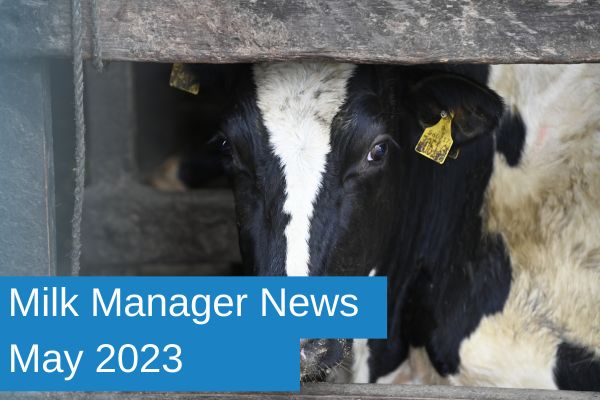Milk Manager News May 2023 – Cows Off Colour? Know The Signs!
10 May 2023Farm staff should be trained how to spot the early signs of health issues in dairy cows, be that metabolic disorders or disease. Many farms have rumination monitors which have been proven to detect health issues such as ketosis or metritis up to two days before clinical signs are seen. Newly calved cows should ruminate for a minimum 450 minutes per day by one-week post-calving. Obviously, a drop in milk yield is an indicator of poor health, but not all farm staff milk the cows or regularly see individual cow milk yield data. Therefore being familiar with the visual signs of cows being off-colour is vital to prevent illness from deteriorating before productivity is significantly impacted.
A healthy cow will be alert and responsive to stimuli, whereas a depressed cow will be less aware of their surroundings, and not as responsive to what is going on around them. The key areas of the animal to examine are:
Eyes
Healthy eyes are bright and alert with no sign of discharge. The eye should sit right up against the bottom eyelid, but if it is sucken inside the orbit the cow may be dehydrated and will likely benefit from fluid replacement. However, in very thin animals, sunken eyes may also be due to loss of fat tissue behind the eye. If the eye is red or has discharge, respiratory disease may be the cause.
Ears
Observe the position of the ears and how warm they feel. Sick animals will have droopy ears and are often cold as well. Cold ears are common with
cases of milk fever due to poor circulation. If the cow has a fever (high temperature), the ears may feel hot.
Nose
Abnormal nasal discharge will be either white, yellow, green or bloody. Also, sick cows don’t tend to clean their noses and so their muzzle will have nasal discharge and feed stuck to it. If the nostrils are dry, it may indicate a fever.
Mouth
A cow not chewing the cud (or with a reduced cudding rate - less than 55 cud chews before swallowing) may be experiencing acidosis. A cow with ketosis may have a smell of acetone (pear drops) on their breath. Teeth grinding (which will be audible) is a sign of pain.
Rumen fill
This is an indicator of feed intake over the last 2-6 hours. Ideally cows in the milking herd should have a rumen fill score of 3 although a score 2 is typical in freshly calved cows in their 1st week of lactation but any cow with a score 1 should be examined. Rumen fill can be assessed by looking at the area underneath the short ribs and between the last rib and the pelvis on the left-hand side of the cow: Rumen fill score card | AHDB
Manure
Manure that is very loose, foul smelling or contains blood can indicate a disease issue, and if acidosis is occuring, the manure will also be very loose and may contain mucin casts or bubbles. If undigested forage particles greater than 0.5 inch long or undigested feed are present, the rumen is not functioning properly. In cases of ketosis the faeces will be very firm.
Udder
Look and feel for anomalies e.g., swelling, heat, reddening, hardness or asymmetry which would suggest mastitis. Udder oedema, which is more typically seen in heifers, may be painful and in extreme cases can damage the suspensory ligaments. Udder fill can indicate how well the cow has been eating and if the udder is not full, it could be due to either illness or a metabolic disease. However, fullness of the udder will obviously vary with time from last milking.
Vaginal discharge
Some uterine discharge is normal for up to a fortnight post-calving and any discharge should be clear and colourless. However, if the discharge is foul-smelling, cloudy or bloody, the cow should be examined and treated as necessary. A watery, reddish-brown discharge is typical of metritis and may be accompanied by a fever and other signs of systemic illness. Endometritis or “whites” does not cause systemic illness but still impacts on fertility so early detection and prompt treatment is still important.
Respiration rate
A normal respiration rate is around 30 breaths/minute, although it can vary between 26-50 breaths/minute. Cows normally breathe through their nose, except when experiencing heat stress conditions where they will breathe through their mouth in an attempt to cool off. Over 100 breaths/minute can be seen in extreme heat stress situations. Fever, pneumonia and pain can elevate respiration rates.
While many technologies exist on dairy farms to monitor health and production, good stockmanship skills are also vital to detect sick animals for observation and prompt treatment.
lorna.macpherson@sac.co.uk; 07760 990901
Sign up to the FAS newsletter
Receive updates on news, events and publications from Scotland’s Farm Advisory Service

